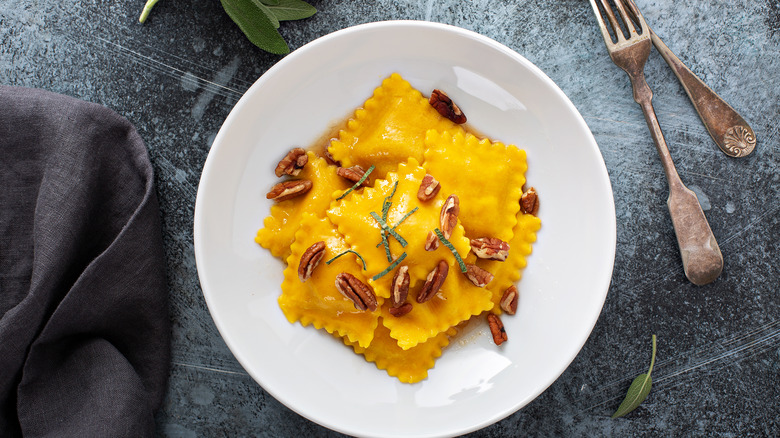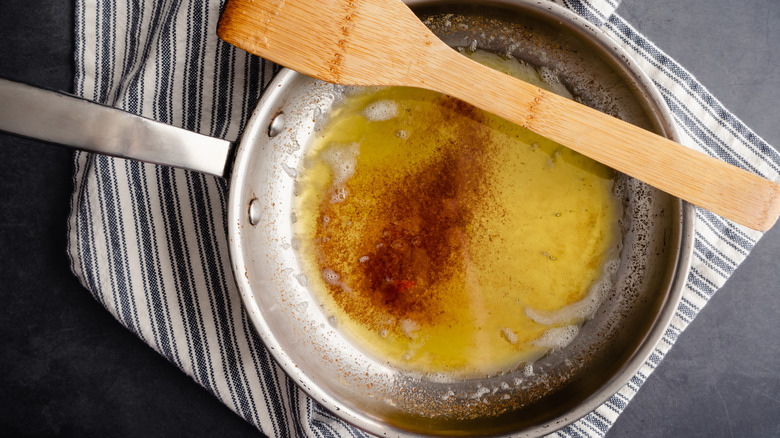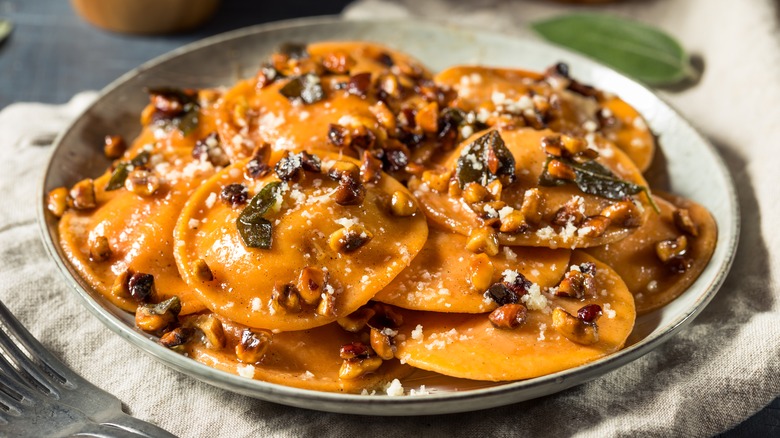Brown Butter Is A Sauce Base Every Pasta Lover Should Know
You've probably seen brown butter on menus before, often matched with pork chops, risotto, scallops, or even in an Old Fashioned; however, this simple yet sophisticated sauce base shines brightest when added to pasta. Brown butter contributes a deep nutty flavor and toasty aroma to a dish without making it too rich or heavy, so it's a delightful pasta sauce all on its own. But brown butter can also be used kind of like a "mother sauce," meaning that it can be paired with other flavors and ingredients such as herbs, nuts, spices, and cheeses, or used as a base for other sauces, like a tomato or a cream sauce.
When it comes to making brown butter sauce, the method is straightforward but the devil is in the details. Understanding the proper technique, equipment, and timing are all integral steps to creating the perfect brown butter. The sauce is deceivingly straightforward — it only requires one ingredient, after all — but there's a lot of technique that goes into successfully making brown butter. Master it, and as long as there's a stick of unsalted butter in your fridge, you have an elegant and elevated sauce at your fingertips.
Making a supreme brown butter sauce
Brown butter sauce is essentially butter that's been cooked past its melting point so that the water evaporates and the milk solids toast and turn brown. To make a basic brown butter sauce, all you need are three things: unsalted butter (we recommend you don't try to brown salted butter), a light-colored pan, which enables you to keep a closer eye on the melting process, and a non-metal stirring utensil such as a rubber spatula, wooden spoon, or a silicone whisk so that you don't damage your cookware when scraping up the browned bits.
First, chop your butter into uniformly sized pieces for even melting. Next, cook the butter slowly over medium heat until it starts to bubble and achieves a golden, straw-like color. Remember to keep stirring to prevent the butter from burning — this can happen quickly if not careful. After a few minutes of cooking, the foam should subside, with the milk solids dropping to the bottom of the pan. Now is the time to check for the tell-tale sign that your brown butter is done cooking – it has an aroma of toasted nuts and caramel.
The final, arguably most important, step is to scrape up all those flavorful buttery bits that have settled on the bottom of the pan. Once this is complete, strain the brown butter sauce into a bowl to prevent it from cooking further. And that's it — your brown butter sauce is ready to go.
Making brown butter into a pasta sauce
The beautiful thing about brown butter is that there are so many variations to the basic recipe. By adding different ingredients, you can alter or enhance the flavor of this simple sauce so that it better pairs with whatever type of pasta you're serving.
One of the most common flavor enhancers is fresh herbs. Sage is a classic addition, but others such as rosemary, thyme, and basil also pair beautifully with dishes like butternut squash ravioli or sweet potato gnocchis. Just remember that when using fresh herbs to add them early in the cooking process to thoroughly infuse the sauce. A variety of spices also complement the rich nuttiness of brown butter such, as nutmeg, or take a different route and give your brown butter an unexpected kick with a dash of garlic powder or red chile flakes.
Brown butter is inherently savory, so you may want to balance the flavor with something tart or sour, such as lemon juice and zest. Another route is to bring in sweetness, and for this, a tablespoon of sugar should do the trick. And when it comes to cheese, you can't go wrong with a sprinkling of nutty Parmesan. You can also combine brown butter with other sauces, like pomodoro or Alfredo, to create a pasta dish that's a true touch of luxury. And to think it all starts with a humble stick of butter.


